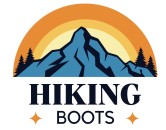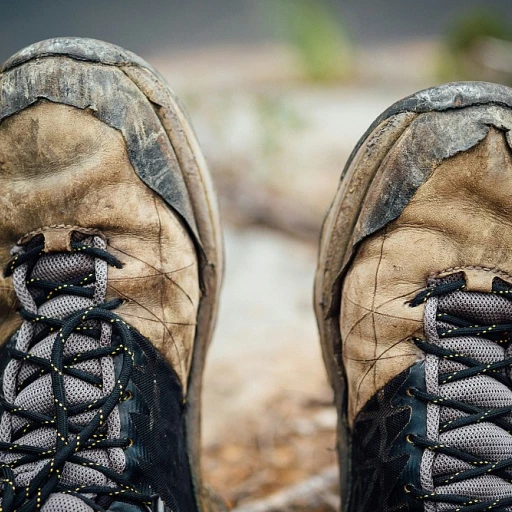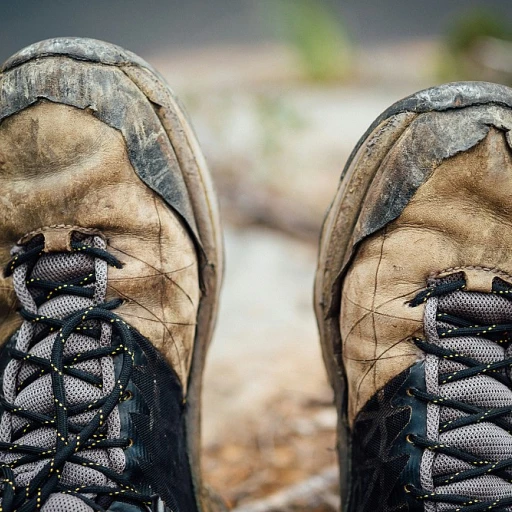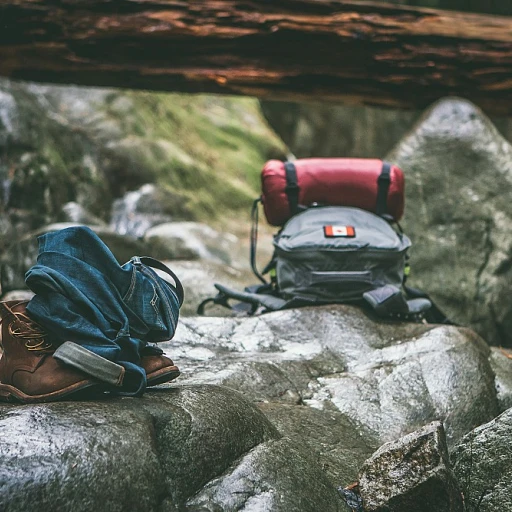
Understanding the Terrain of the Appalachian Trail
Exploring Terrain Challenges
The Appalachian Trail offers a diverse range of terrains that can challenge even the most seasoned hikers. As you embark on this magnificent trek, understanding the terrain becomes crucial to crafting an efficient gear strategy, such as choosing the best bear canister for food storage.
From the rolling hills of Georgia to the rocky paths of New Hampshire, the Appalachian Trail is notorious for its unpredictable weather and varied topography. This means that hikers must be ready for changes in elevation, rough surfaces, and uneven footings. Conditions can shift swiftly from dirt paths to rocky outcrops, muddy trails, and occasional streams or water crossings. All these factors emphasize the importance of a carefully chosen hiking boot that can tackle both wet and dry conditions.
Ensuring you have the proper gear, including a reliable rain jacket and a good pack to manage the weight of essential items like a sleeping bag, water, and food, is vital for safety and comfort. It's essential to consider the trail’s specific challenges, as pack weight significantly affects your physical endurance and how agile you can be while navigating rocky terrains or climbing steep inclines.
For many, using trekking poles and opting for a segmental approach with predetermined rest points can make the physical demands more manageable. This effort-to-energy balance is a fine line to walk, especially considering the diverse ecosystem that the trail offers, which can quickly alter your planned pace. Thus, the gear you select has to be versatile enough to adapt to varying weather conditions, particularly in the rain-prone areas.
Choosing the Right Hiking Boots for the Appalachian Trail
Decoding the Art of Selecting Trail Boots
No adventure on the Appalachian Trail is complete without the right pair of hiking boots. With varying terrains and unpredictable weather patterns, ensuring a steady foot on the trail is crucial. Here's what to keep in mind:- Terrain Compatibility: The Appalachian Trail is diverse, featuring rocky paths, muddy stretches, and sometimes snow-covered routes. Therefore, choosing boots that can handle different landscapes is essential. Look for multi-terrain designs to ensure you don’t get caught off guard.
- Weight Matters: The weight of your boots can affect your entire hike. Each ounce counts when you're a week deep into the trail. Balance being lightweight with having enough sturdiness. Consider how boots will fit into your overall pack weight and load distribution.
- Water Resistance: Wet feet can lead to discomfort, blisters, and even more severe issues. Opt for boots with effective water-repellent materials. Test their waterproof capabilities by checking reviews and field tests.
- Comfort and Fit: It's vital that boots fit well, with no pinching or pressure points. Try them on with the socks you plan to use during your hike to ensure a snug fit. A good hiking boot should provide ample room for your toes while offering strong ankle support.
- Ventilation: Keeping your feet dry goes beyond waterproofing. Even on a rainy day, your feet need to breathe. Boots with breathable fabrics can prevent excessive sweating and reduce the risk of blisters.
Features to Look for in Hiking Boots
Key Attributes for Selecting Top-Tier Hiking Boots
When embarking on the Appalachian Trail, choosing the best hiking boots tailored to the challenges and characteristics of the trail is vital. As you prepare your gear, consider these essential features that will make your journey both safe and enjoyable.- Durability: Given the Appalachian Trail's rugged terrain and unpredictable weather, your hiking boots must withstand constant wear and tear. Pay attention to materials like leather or high-quality synthetics that offer toughness without adding excessive weight to your trail gear.
- Comfort: The trail's undulating paths demand footwear that provides comfort for long hikes. Look for boots with adequate cushioning and supportive insoles, such as those crafted by trusted brands like Black Diamond or Gossamer Gear. Your sleeping bag may give you respite, but comfort should be a constant companion on the trail.
- Water Resistance: Appalachian rains can transform stretches of the trail into muddy challenges. Boots with reliable water-resistant membranes, like Gore-Tex, keep your feet dry and are an indispensable part of your rain gear alongside your rain jacket and stuff sack.
- Breathability: While water resistance is crucial, breathability ensures your feet stay dry from internal moisture build-up. Proper ventilation in your hiking boots reduces the risk of blisters and discomfort, essential for maintaining a solid pace.
- Traction: Footwear with excellent grip is a must, given the trail’s mix of rock, dirt, and potential mud. Opt for boots with deep lugs that provide a firm hold, allowing you to confidently tackle inclines and wet surfaces alike.
- Weight: As pack weight is a constant consideration, lightweight boots are advantageous. The less weight on your feet, the less energy expended, letting you conserve energy for your sleep system setup with sleeping pads and sleeping bags from brands like Thermarest or Big Agnes.
Breaking in Your Hiking Boots
Ensuring Comfort on Your Journey
Before setting out on the Appalachian Trail, it's crucial to ensure that your hiking boots are well broken in. A common mistake is hitting the trail with brand-new boots, which can lead to blisters, discomfort, and an unhappy trek. Investing time in preparing your gear is as essential as the rest of your trail gear list.
The First Steps: Wearing New Boots at Home
Begin the break-in process by wearing your boots around your home with the same – or similar – socks you plan to use during the hike. This helps your feet adjust to the fit and feel while starting to soften the material of the boots.
Take Short Walks
Gradually, you can take your boots outside for short walks. Opt for routes with a mix of surfaces – pavement, dirt, and perhaps even some inclines – to mimic the diverse trail conditions you'll encounter. You may already be aware that each step is a form of investment in a smooth hiking experience.
Load Up: Adding Pack Weight
Once your feet are comfortable, simulate the conditions of the trail by adding pack weight. Wearing a backpack filled with essentials like your tent, sleeping bags, and food water can help you adapt to the added pressure on your feet and replicate the actual hiking scenario. This way, your boots won’t be the only items adjusting to trail life; your entire gear setup including trekking poles, rain jacket, and sleeping pad will also be accounted for.
Address Any Discomfort
Pay close attention to any spots where discomfort or hot spots appear. These are early indicators of potential issues that may arise during the hike, especially on more challenging terrain. Some minor adjustments with trekking poles or gear arrangement can dramatically elevate your hiking experience.
Know When Enough is Enough
Finally, understanding when your boots are adequately broken in is key. Once you can comfortably complete longer walks with your full gear setup, including a big agnes sleeping bag or a gossamer gear pack, you'll be ready to tackle more adventurous trails with confidence and ease.
Maintaining Your Hiking Boots on the Trail
Keeping Your Boots in Top Condition
When you're on the Appalachian Trail, maintaining your hiking boots is crucial to ensure they last the entire journey. The trail's diverse terrain can be tough on your gear, so regular care is essential. Here are some tips to keep your boots in top condition:
- Clean Regularly: After a long day of hiking, take a few minutes to clean off mud and debris. Use a soft brush and water to gently remove dirt. This prevents the buildup of grime that can degrade the material over time.
- Dry Properly: Wet boots can lead to discomfort and blisters. Avoid drying them directly in the sun or near a campfire, as excessive heat can damage the material. Instead, stuff them with newspaper or a stuff sack to absorb moisture and let them air dry.
- Check for Wear and Tear: Regularly inspect your boots for signs of wear, such as thinning soles or loose stitching. Addressing these issues early can prevent bigger problems down the trail.
- Waterproofing: Even if your boots are waterproof, it's a good idea to reapply a waterproofing treatment periodically. This helps maintain their resistance to rain and wet conditions, which are common on the trail.
- Rotate Your Socks: Keeping your feet dry is just as important as maintaining your boots. Rotate your socks and use a good pair of trekking poles to help reduce the impact on your boots, especially in rocky areas.
By taking these steps, you'll ensure your boots remain a reliable part of your trail gear. Remember, your boots are one of the most important items in your pack, so giving them the attention they deserve will pay off in comfort and durability throughout your hike.
Alternatives to Traditional Hiking Boots
Exploring Other Footwear Options for the Trail
Pioneers of the Appalachian Trail often opt for alternatives to the traditional hiking boots, striving for innovations that can enhance adventure experiences. As the miles stretch ahead of you, trail runners have become a popular choice for those seeking a lighter impact and flexible movement. While they lack the robust ankle support of hiking boots, they make up for it with reduced pack weight and breathability, essential attributes for long treks. Considerations for such alternatives include:- Weight and Mobility: Trail runners are typically lighter than traditional boots, making them excellent for maintaining a brisk pace and easing the pressures of carrying hefty gear.
- Breathability and Water Resistance: Many trail runners are equipped with breathable materials that keep feet dry under most conditions, though during persistent rain, a good rain jacket and quick-drying socks might be vital allies.
- Durability: Over rocky terrains or challenging conditions, traditional hiking boots provided the sturdiness needed. However, with advancements in materials, some trail runners now offer competitive durability.














